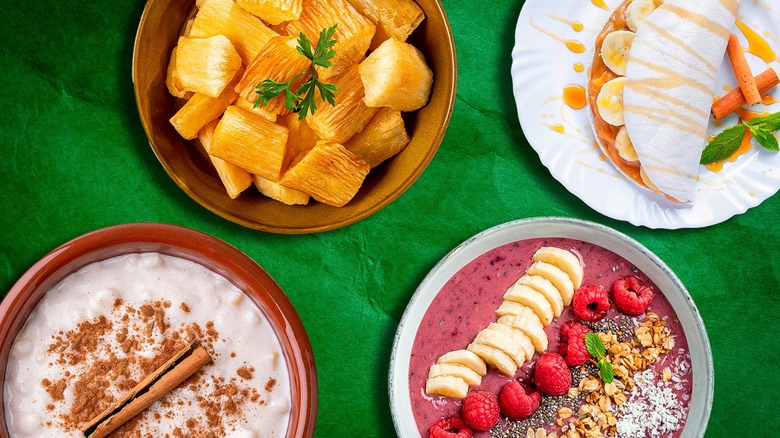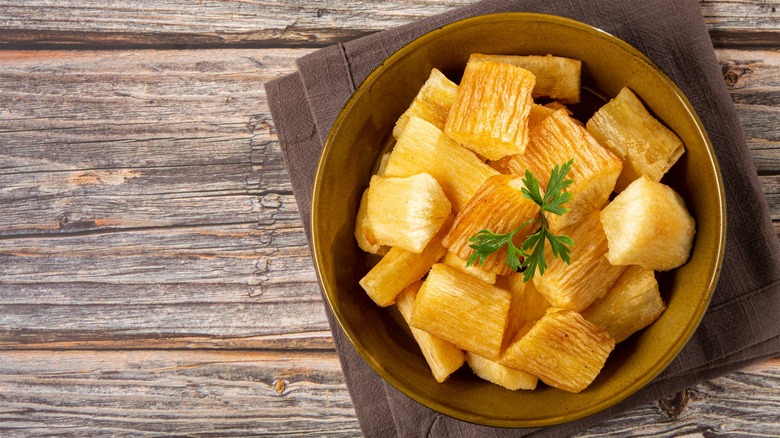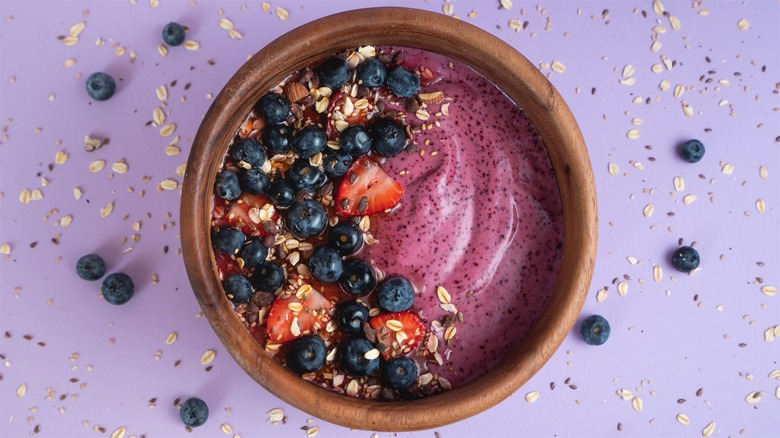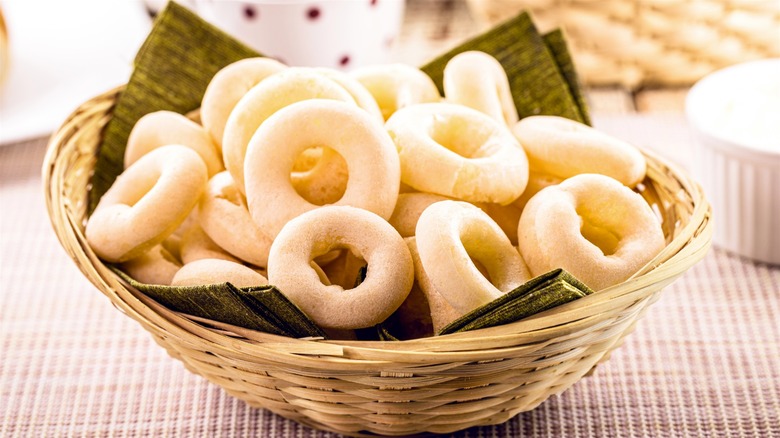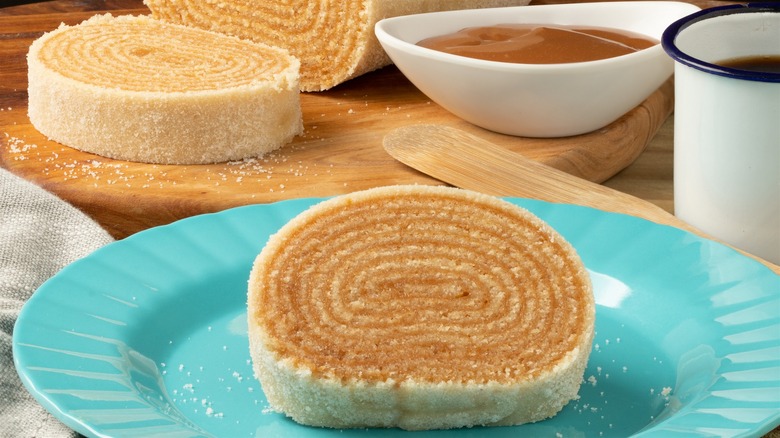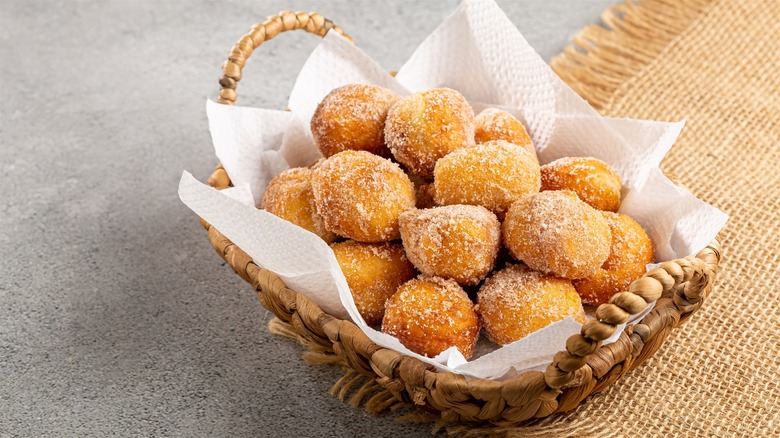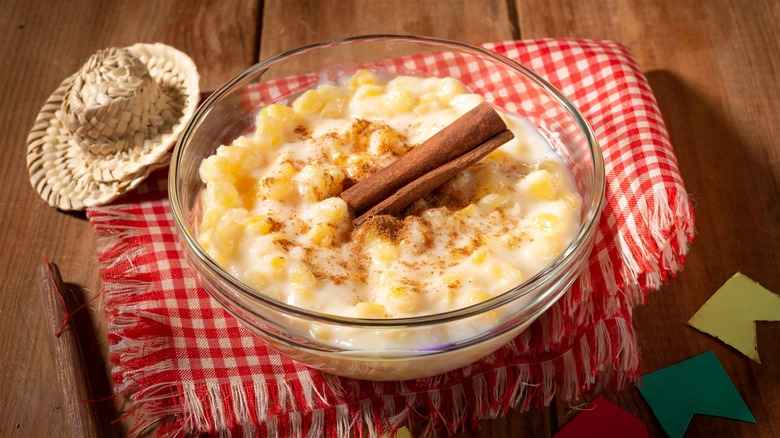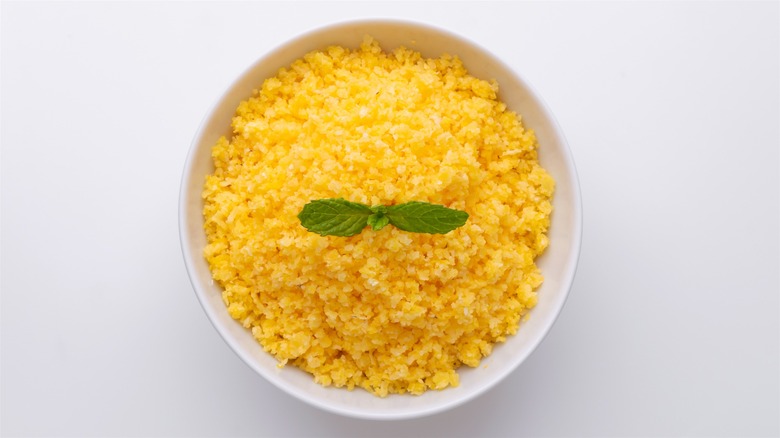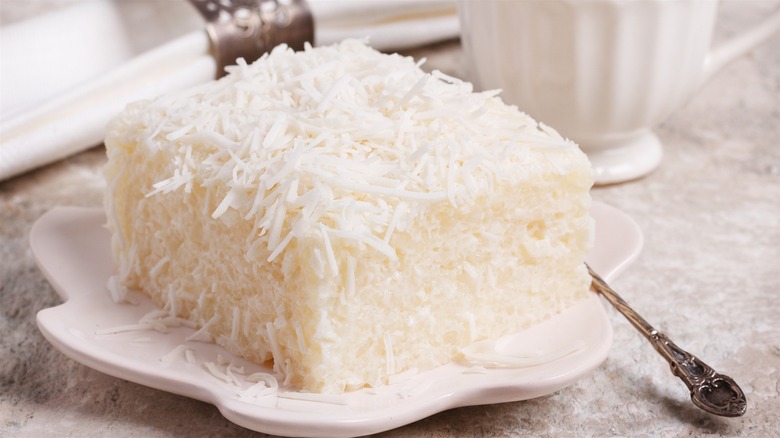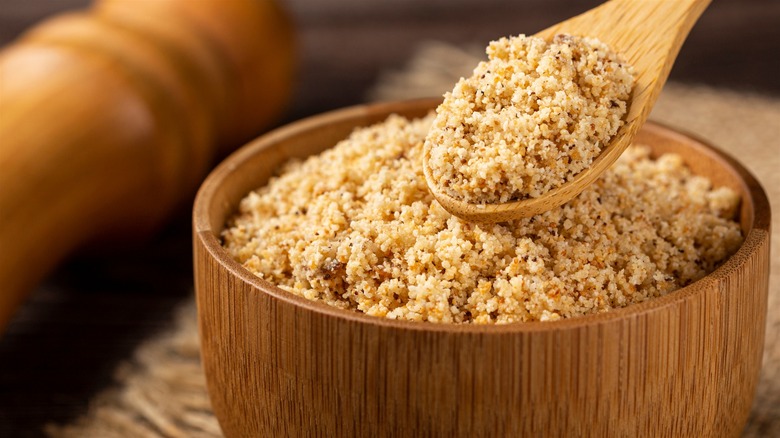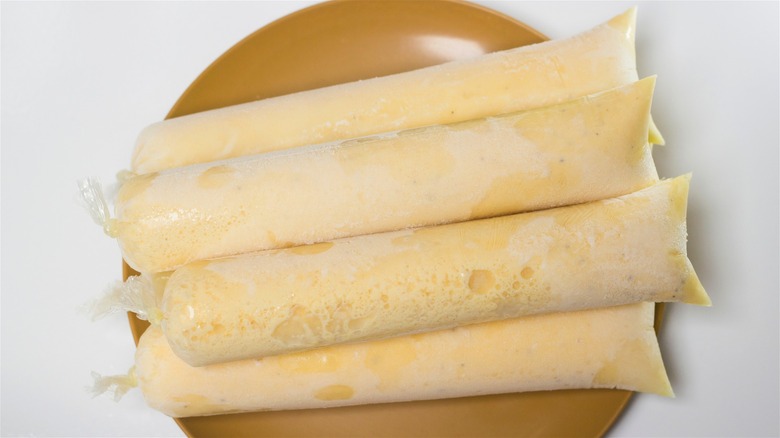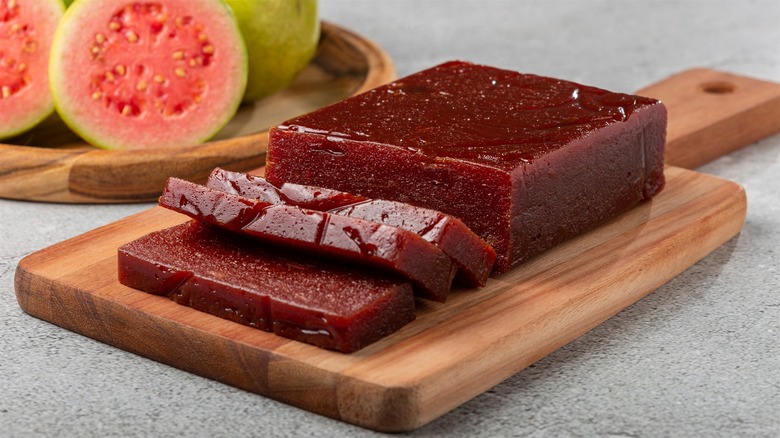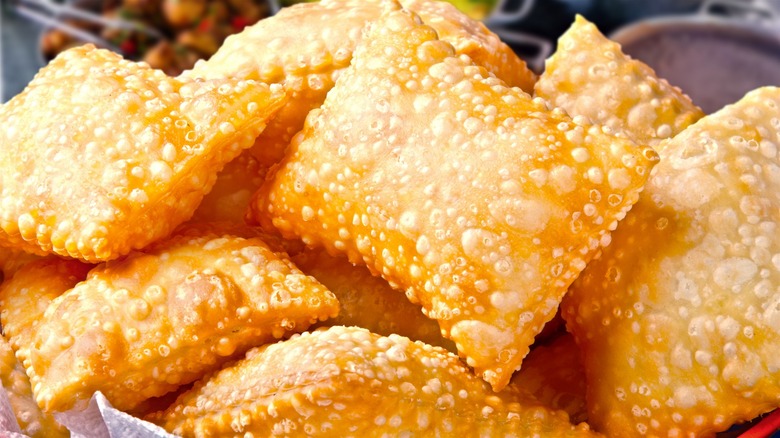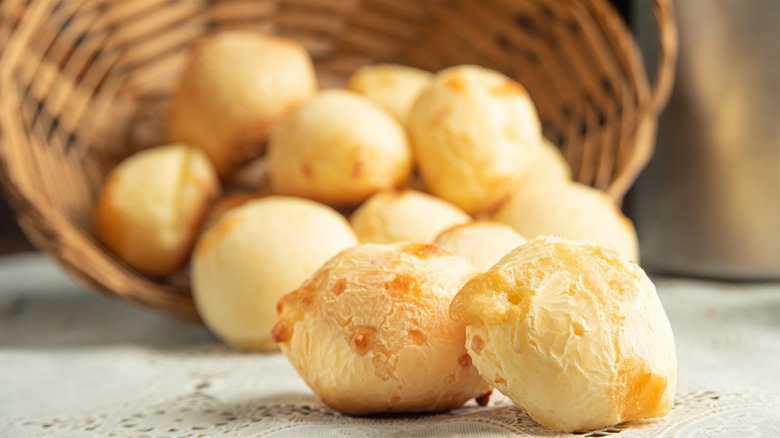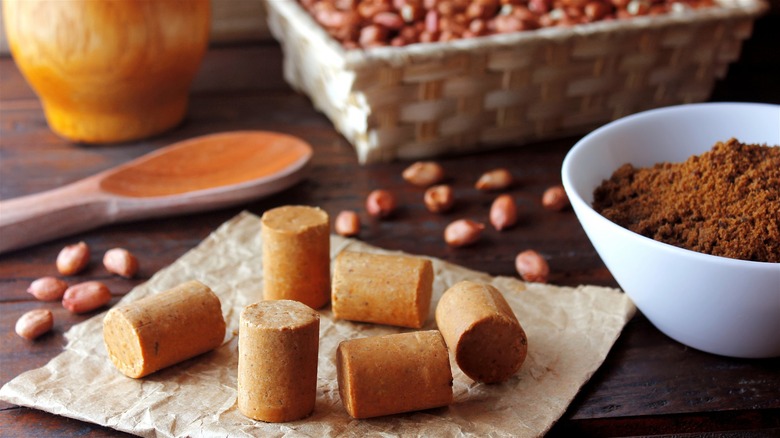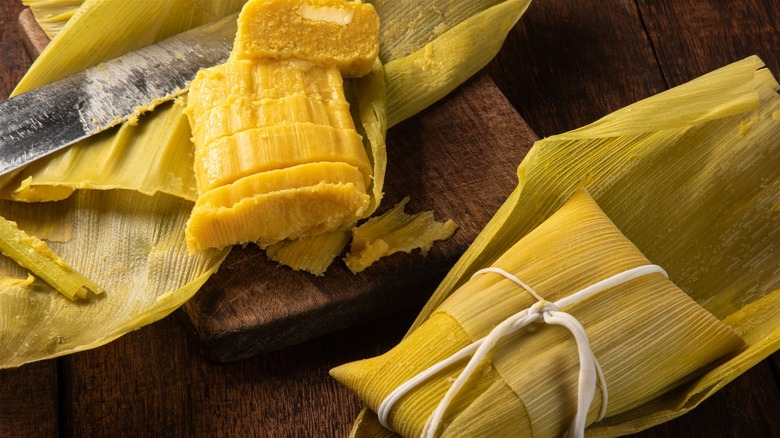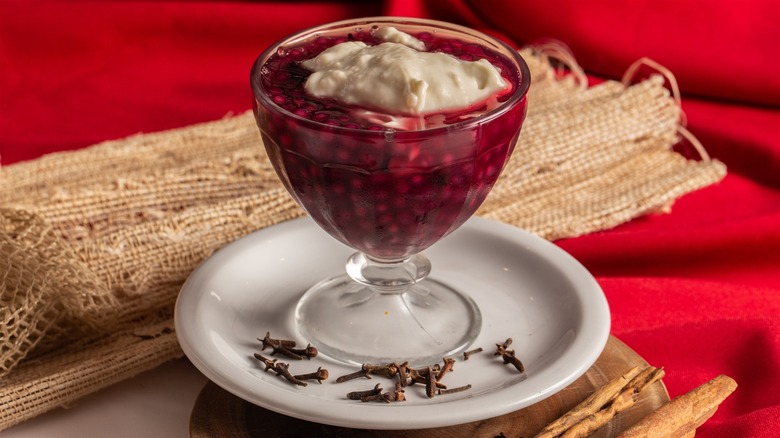21 Vegetarian Brazilian Dishes You Need To Know
If you had to describe Brazilian food in one word, what would it be? Probably not "vegan-friendly." It's true: While there are plenty of iconic Brazilian dishes, very few are vegetarian or fully plant-based. But while Brazil can't yet join the ranks of notably vegan-friendly cuisines, there is no shortage of vegan options at restaurants and supermarkets, as the country's population is making a slow, but steady movement towards plant-based eating. In fact, per Statista, a remarkable 14% of Brazilians, totaling 30 million people, identified as vegetarian in 2018.
Most traditional vegetarian options are made from the same essential Brazilian ingredients like cassava and its derivatives, corn, peanuts, coconuts, hearts of palm, beans, and fruit, as well as numerous forms of dairy. But what these dishes may lack in nutritional diversity, they make up for with historical background and cultural significance, marking their place in a Brazilian culinary tapestry woven together by centuries of movement and influence. Here are some of the most delicious vegetarian Brazilian dishes to try.
Aipim Frito
Fries are the ultimate savior of plant-based eaters everywhere, no matter how meat-heavy the scene is. But aipim frito are no ordinary fries. They're made from one of the most essential ingredients for Brazilian cooking: manioc. Known alternatively as cassava or yuca, the tuber serves as one of the primary sources of carbohydrates in the national diet. It is relished both as a vegetable and for the versatile tapioca starch extracted from it.
Compared to its American counterpart, this popular street food boasts a sturdier, blockish shape and an intriguing, somewhat fibrous texture that nevertheless melts in your mouth. Found on bar menus everywhere, it is best enjoyed straight out of the fryer, with a pinch of salt, some hot sauce if you're feeling it, and a glass of cold beer.
Acarajé
Acarajé (pronounced ah-kah-rah-JEH) isn't just an exotic street food; it's a dive into Afro-Brazilian culture, its name hinting at its fiery taste — a "fireball to eat." Common in Bahia and sold exclusively by "baianas" in traditional dress, this dish was originally brought to Brazil by enslaved people from the Gulf of Benin, and later became central to Candomblé rituals. Despite its sacred origin, today, acarajé is an affordable street fare.
Originally, this fritter was completely plant-based: Made from black-eyed beans and onions beaten into a paste, shaped, and fried in palm fruit oil known as dendê, acarajé offers a crispy shell with a creamy heart. Beware if you have allergies; these days, it's stuffed with shrimp-containing paste such as vatapá or carurú. Yet, vegan options exist, replacing those with salad or omitting shellfish.
Açaí na tigela
You might know açaí bowls as a frosty breakfast staple, but it didn't start out this way. Açaí na tigela, or "açaí in the bowl," is made from the berries of açaí palm, which were a reliable energy source for centuries, especially in times of scarcity. Unlike the fruit-topped versions common elsewhere, in the northern state of Pará, where most of the world's açaí comes from, it is served thickened with cassava flour and accompanied by fish or shrimp.
The transformation from an obscure northern dish to a health food craze began in the 1980s, thanks to Carlos Gracie, a Pará local of Brazilian jiu-jitsu fame, who popularized açaí bowls in his diet. Later, guaraná syrup was added to the mix for a more marketable flavor that eventually conquered the country ─ and the world.
Beiju de tapioca
Beiju de tapioca, Brazil's starchy take on the crepe, is a flatbread with pre-colonial, indigenous roots. Ubiquitous in Brazil's north and northeast regions (where it's celebrated as an immaterial and cultural heritage symbol) and a staple on Rio's beaches, it's now found everywhere from street carts to hotel buffets.
Known as beiju in Salvador and tapioca elsewhere, it's naturally gluten-free, fat-free, and vegan, crafted from rehydrated cassava starch. The crepe itself doesn't taste like much; instead, it provides a paper-white blank canvas for whatever sweet and savory fillings are chosen for it. But its texture is surprising: Despite looking dry and crunchy, it's melt-in-your-mouth stretchy. Tapioca pairs with a variety of fillings, from chocolate and fruit to meat and dairy, with lots of places serving vegan options.
Biscoito de polvilho
Biscoito de polvilho (pronounced bee-SKOHY-toh dee pohl-VEE-lyoh), more snack than meal, offers a crunchy bite of Brazilian food culture. Hailing from the state of Minas Gerais and dating back to colonial times, these airy, starchy morsels are now commonplace. Can you guess what kind of starch they're made from? Tapioca, of course! Only in this case, it's fermented first, lending the cookies a lightly tangy flavor. Eggs, milk, and vegetable oil contribute to their unique puffiness and a crunchy exterior.
Available in shapes from breadsticks to donut-like rounds, they're a common find along Brazil's picturesque beaches, corner stores, and supermarkets, with egg-free, coconut milk-based versions available for the vegan crowd. This traditional treat, often enjoyed with cheese and coffee, tastes even better with a side of refreshing Brazilian yerba mate at the beach.
Bolo de rolo
Another gift to vegetarians from the northeast, bolo de rolo is one of those Brazilian desserts you need to try at least once. Not every cake has earned the title of "intangible cultural legacy," after all. This refined dessert has likely evolved from the Portuguese "colchão de noiva" in the 17th century, completely transforming the original almond-filled sponge cake.
The name translates to "rolled cake," aptly describing its appearance, achieved by rolling pastry sheets with guava filling into a log of 16-20 layers. Once a luxury reserved for sugarcane plantation owners, it now graces coffee tables across Brazil. The modern fillings vary, but the thin, innumerable layers remain its signature feature. It's commonly served in Brazilian stores and cafes.
Bolinho de chuva
The name of this Brazilian beignet relative roughly translates to "rain cake," and one look at it explains why. Pronounced boh-LEEN-yo jee SHOO-vah, it's named for its raindrop shape and the coziness it brings on drizzly days. Traditionally homemade, these pillowy deep-fried drops evoke nostalgia, with no two family recipes exactly alike. The simple batter generally combines wheat flour, eggs, sugar, milk, and baking powder and is similar to choux.
Likely derived from Portuguese filhoses or sonhos, these treats ─ referred to as bolinhos de negras in the past ─ were transformed through the culinary ingenuity of enslaved people. Today, bolinhos de chuva, dusted in cinnamon sugar and deep-fried to perfection, can be easily recreated at home, even without animal products, making this delicacy accessible beyond Brazilian borders.
Canjica (Mugunzá)
Should you ever visit Brazil in June, keep an eye out for corn-based dishes, such as canjica de milho. This comforting food is synonymous with Brazil's Festa Junina, a celebration of corn harvest in June's winter chill. Pronounced kahn-ZHEE-kah jee MEEL-yoh, this creamy concoction varies regionally and is known as munguzá in the north.
Originating in the 17th-century Afro-Brazilian community and enslaved population's culinary tradition, it transforms hominy ─ white corn made tender through nixtamalization ─ into a dessert by simmering it with milk, shredded coconut, and sugar. The outcome is a spoon-worthy, soupy substance that marries spices with sweetness in a dish that highlights hominy's versatility. Served warm in the winter, it is more akin to porridge, whereas its chilled pudding-like form is preferred in the hotter months.
Cocada
Cocada, pronounced koh-KAH-dah, is a general term for various coconut-based confectionaries throughout Latin America. Considering Brazil is one of the world's largest producers of coconut, it's no wonder it's featured prominently in the nation's culinary landscape. Brazilian cocada was initially tied to the Candomblé religion, where it was served as "comida dos orixás" or food of the gods.
The sweet comes in many forms ─ from the rustic cocada de corte, where a mix of coconut, sugar, and condensed milk is either quenelled or rolled out and cut into squares to air dry, or cocada de forno, a baked golden-brown custardy version, to cocada cremosa which diverges as a pudding. Here, coconut pieces are cooked with the usual suspects: condensed and coconut milk, with a lavish addition of heavy cream, catering to dairy enthusiasts.
Curau
Curau is canjica's fraternal twin. It, too, is a corn pudding, has deep roots in the country's culinary history, and can often be found at Festa Junina celebrations. Even the word "curau" is synonymous with "canjica" in some regions! But there's one difference. While canjica is made from hominy, curau is prepared with its yellow counterpart ─ and can even serve as one of the ways to transform canned corn into a dessert when fresh cobs aren't in season.
At the end of the day, it's a simple mix of fresh corn blended with milk and sugar and cooked until pudding-like, served chilled with a generous sprinkle of ground cinnamon on top. The unobvious charm of curau is how easily it is veganized by swapping out the dairy for any plant-based milk.
Cuzcuz nordestino
Brazil has many variations of couscous dishes, but, for the most part, they're nothing like their North African namesake. After the Portuguese colonizers introduced the original to Brazil, it underwent some major changes. For one, "cuzcuz" is mainly made of cornmeal, not wheat. Unlike the lavish, Bundt-shaped cuzcuz Paulista that relies heavily on shrimp, eggs, and meat, cuzcuz Nordestino is a humble vegetarian-friendly breakfast dish. Traditionally, it's steamed, rather than boiled, in a special cuscuzeira pan, resulting in a sliceable porridge.
The northeastern couscous is a staple found on both home tables and restaurant menus. It's commonly served hot with local cheese, a dollop of butter, or coconut milk. Whether sweet or savory, its largely unassuming flavor pairs beautifully with freshly brewed coffee, standing as a cornerstone of northeastern Brazil's breakfast scene.
Cuzcuz de tapioca
If you thought there was only one cuzcuz hailing from Brazil's northeast, think again. Introducing: cuzcuz de tapioca. Deeply embedded in the country's culinary history, this dish shines as a beloved treat in the north and northeast, particularly in Bahia. Like many other dishes of the region, its heritage can be traced to the enslaved population of Brazil.
Also known as cuzcuz branco, this sweet and creamy pudding-like dish is prepared from ─ you guessed it ─ tapioca granules, as well as coconut, sugar, and milk. Not confined to high-end restaurants, cuzcuz de tapioca thrives as a street food staple, especially among beach vendors in Rio de Janeiro, blurring the lines between snack and dessert. It's also a festive treat, found at Festa Junina, as well as Christmas tables.
Farofa
Affordable and ubiquitous, farofa is somewhere between a starchy side dish and a crunchy topping (think seasoned breadcrumbs). It might not look like much, but Brazil's national dish, feijoada, wouldn't be the same without it. This dish, with roots stretching back to pre-colonial times, was originally a staple in the diet of the Tupi-Guarani peoples before conquering Portuguese palates.
Naturally gluten-free, it uses corn or cassava flour (not to be confused with tapioca starch) as a bland base to be infused with other flavors, which are often not vegetarian. However, you can still find vegan farofa in Brazil or make your own by toasting the flour with oil, alliums, and spices. And remember: If farofa's role in your meal seemed underwhelming, you've not yet had the genuine, flavor-packed experience that this traditional dish promises.
Geladinho (Sacole)
The Brazilian take on freezer pops goes by many names. Some, like geladinho, refer to its temperature, while others, like sacolé, hint at their plastic casing. Still others, like chup-chup, seem like an onomatopoeic reference to the eating experience. But no matter what you call them, these stickless, tube-shaped frozen treats offer a universally appreciated respite from the heat, whether they're homemade or bought off a street vendor.
In terms of contents and ease of preparation, geladinhos are more similar to smoothies than sorbets. The ingredients, featuring local fruit and a mix of regular and condensed milk, are simply blended together, encased in plastic bags, and frozen ─ no additional mixing required. Homemade sacolé can easily be adapted for plant-based eaters or even spiked with cachaça or vodka for an adult twist.
Goiabada
This quintessentially Brazilian fruit preserve can be classified as fruit cheese with a romantic, nostalgic undertone. It is crafted from guava pulp and sugar, traditionally made with fruit peel in copper pots, and cooled in banana leaf-lined cedar boxes to achieve a sliceable consistency. Today's goiabada comum might skip the peels and copper pots but retains its charm. It is available as a creamy spread commonly used as the bolo de rolo filling, or as a firmer option used for slicing into desserts.
Despite coming from Minas Gerais, a state known for its dairy, goiabada is fully vegan. However, its heritage is reflected in the iconic Romeu e Julieta dessert. This pairing of salty cheese and sweet preserve captures the essence of Brazilian cuisine, creating a perfect bite that harmonizes contrasting flavors.
Pastel
Introduction to Brazilian street food should undoubtedly start with pastéis. Typically found in the bustling ambiance of Sunday farmers' markets, paired with the refreshing zing of cold sugarcane juice, pastéis are irresistibly crispy and delightfully versatile. Despite its humble appearance, the pastel's origins hint at a complex cultural tapestry, possibly inspired by immigrant adaptations of Chinese wontons or Japanese gyoza.
The delicate dough, a blend of flour, salt, water, oil, vinegar, and an obligatory dash of cachaça, encapsulates fillings in either a rectangular or half-moon shape. The latter is a favorite for its generous stuffing, ranging from simple to gourmet. With options like minced beef, heart of palm, and the sweet twist of goiabada with cheese, pasteis can swing from non-vegan to vegetarian to fully plant-based without missing a beat.
Pão de queijo
No list of vegetarian Brazilian foods would be complete without pão de queijo. But first things first: Master its pronunciation, lest you want to find yourself in an awkward position referring to a male's appendage. It's pown (not pa-o!) jee kay-zho. With that out of the way, nothing is stopping you from trying this delectable, cheesy snack. Originating in Minas Gerais, it has evolved from enslaved peoples' plain cassava-based dough balls to include cheese, eventually becoming a nationwide sensation.
Aside from cheese, the main ingredient is fermented cassava flour, which gives it a distinct sour edge. Pão de queijo is naturally gluten-free, making it a go-to treat for many, enjoyed with an espresso any time of the day. For those avoiding dairy, plant-based versions are also available, ensuring no one misses out on this chewy, doughy snack.
Paçoca de amendoim
Another beloved Festa Junina treat, paçoca (or paçoquinha) can fortunately be found at local stores, juice bars, and gas stations all year. Its name, pronounced as pah-SOH-kah, comes from "posok," a Tupi word for crushed or shattered, alluding to the nature of this dish. The "amendoim" part refers to the main ingredient ─ peanuts ─ and helps distinguish it from the meaty paçoca nordestina, an entirely different beast.
The crushed peanuts, mixed with sugar, salt, and sometimes a whiff of cassava flour, are traditionally molded into cork-shaped cylinders. Store-bought versions, particularly by the Paçoquita brand, resemble boullion cubes. Enjoy this versatile, calorie-dense snack on its own, or get creative by crumbling it over ice cream, sprinkling it over drinks, or even blending it into a frosty cocktail with cachaça and condensed milk.
Pamonha
If you've ever tried Mexican tamales, you might think nothing about pamonha could surprise you, but you'd be wrong. Unlike its hominy-based cousin, pamonha (read as pah-MOHN-yah) celebrates fresh corn, so it's no wonder it takes center stage during the June corn harvest festivities. Its name, stemming from the indigenous Tupi language, alludes to its sticky, mushy texture that's carefully encased in corn leaves. Inside, you'll find fresh corn kernels blended with coconut, milk, and sugar, or a mix of cheeses for a savory twist.
Affordable and deeply rooted in tradition, pamonha embodies the essence of Brazilian street food. Making it is a communal endeavor that often sees families coming together in a ritual known as pamonhadas. The resulting delicacies are frequently sold in street markets year-round.
Pé-de-moleque
Pé-de-moleque, pronounced "peh-jee moh-LEH-keh," is a traditional Brazilian sweet treat that's as fun to eat as it is to say. Intriguingly, it is one of those deceptively named foods. The word translates to "brat's foot," a whimsical nod to its rustic, rough texture reminiscent of the cobblestone streets that barefoot boys might once have trodden, and a reference to a legendary young candy thief who couldn't be stopped by screams of "Pede, moleque!" ("Ask for it, kid!").
This crunchy peanut brittle is a staple during Festa Junina but cherished year-round. At its core, pé-de-moleque is a simple confection made from roasted peanuts embedded in a hard caramel, crafted from molasses or rapadura (unrefined whole cane sugar), which gives it a distinctively rich, smoky sweetness. It's an affordable indulgence found everywhere, from street vendors to high-end confectionery stores.
Sagu
Sagu de vinho tinto is a cherished dessert in the southern regions of Brazil, where European influence is palpable in its culinary traditions. This isn't your average bubble tea ─ each bite is a journey to the wine-soaked heart of southern Brazil. This traditional tapioca pearl pudding, often served with an optional dollop of créme anglaise, is easy to whip up at home, and naturally plant-based (provided you use vegan wine).
Steeped in spiced red wine, the pearls are simmered until they reach a perfect, jewel-toned translucency. Sweetened with sugar and often infused with cinnamon, anise, and clove, sagu offers a harmonious blend of the rich, full-bodied flavor of wine with the subtle, comforting warmth of spices. Typically served chilled, it provides a refreshing finale to a hearty meal, making a sophisticated yet comforting dessert.
Static Media owns and operates Tasting Table and Mashed.
